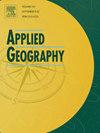Impact-driven spatial planning for future-proofing small island states: A scenario-based land model analysis in Curaçao
IF 5.4
2区 地球科学
Q1 GEOGRAPHY
引用次数: 0
Abstract
The sustainable development of small island states faces complex challenges exacerbated by their unique vulnerabilities and limited resource bases. Global change and pressures can be reflected locally in the use of land in these territories, with attendant socio-economic and environmental consequences borne by inhabitants and ecosystems. In this study, we propose an integrated approach combining participatory Bayesian networks, land use modelling, and multi-criteria impact analysis to explore three development pathways for 2050 constrained by alternative spatial planning options in Curaçao. Zoning regulations are shown here to limit sprawling built-up patterns and confine development to specific segments of the coast, reducing loss of rare vegetation by an average of 32 % and reducing added nutrient fluxes to the coastline by up to 22 %. Outcomes arising from unregulated development typically perform worst in terms of marginal environmental impacts per added value. Ultimately, this research contributes practical insights for decision makers grappling with the intricate challenges of spatial development in small island contexts, fostering planning debates and aiding in the navigation of intersectoral conflict. By elucidating the relationships between zoning regulations, socio-economic drivers, and environmental outcomes, the study supports informed decision-making towards achieving sustainable development goals amidst uncertainty and resource constraints.
面向面向未来的小岛屿国家的影响驱动空间规划:基于情景的库拉帕拉索土地模型分析
小岛屿国家的可持续发展面临着复杂的挑战,它们独特的脆弱性和有限的资源基础加剧了这些挑战。全球的变化和压力可以反映在这些领土的土地使用上,从而给居民和生态系统带来社会经济和环境后果。在这项研究中,我们提出了一种结合参与式贝叶斯网络、土地利用模型和多标准影响分析的综合方法,以探索受其他空间规划方案约束的2050年库拉帕拉索三条发展路径。这里显示了分区法规,以限制扩张的建筑模式,并将开发限制在海岸的特定部分,将稀有植被的损失平均减少32%,并将海岸线的额外营养通量减少多达22%。就每增加值的边际环境影响而言,不受管制的发展所产生的结果通常表现最差。最终,本研究为决策者应对小岛屿环境下空间发展的复杂挑战提供了实际见解,促进了规划辩论,并帮助解决部门间冲突。通过阐明分区法规、社会经济驱动因素和环境结果之间的关系,该研究支持在不确定性和资源限制下实现可持续发展目标的明智决策。
本文章由计算机程序翻译,如有差异,请以英文原文为准。
求助全文
约1分钟内获得全文
求助全文
来源期刊

Applied Geography
GEOGRAPHY-
CiteScore
8.00
自引率
2.00%
发文量
134
期刊介绍:
Applied Geography is a journal devoted to the publication of research which utilizes geographic approaches (human, physical, nature-society and GIScience) to resolve human problems that have a spatial dimension. These problems may be related to the assessment, management and allocation of the world physical and/or human resources. The underlying rationale of the journal is that only through a clear understanding of the relevant societal, physical, and coupled natural-humans systems can we resolve such problems. Papers are invited on any theme involving the application of geographical theory and methodology in the resolution of human problems.
 求助内容:
求助内容: 应助结果提醒方式:
应助结果提醒方式:


